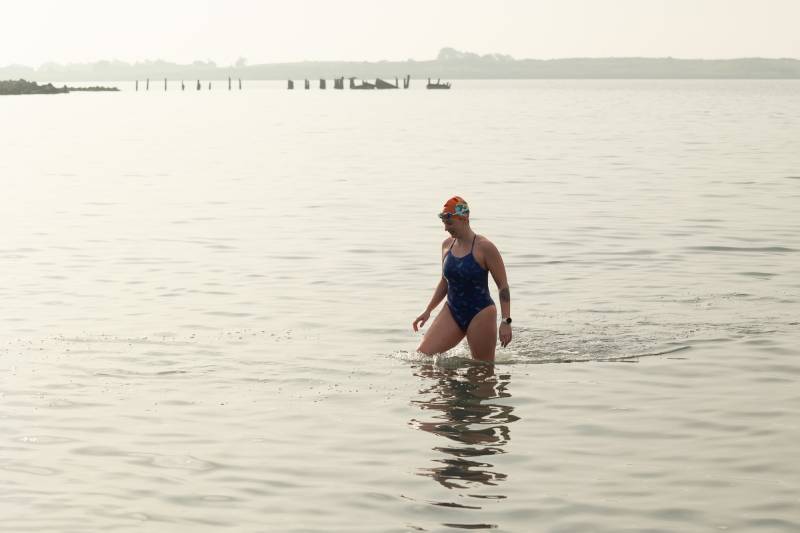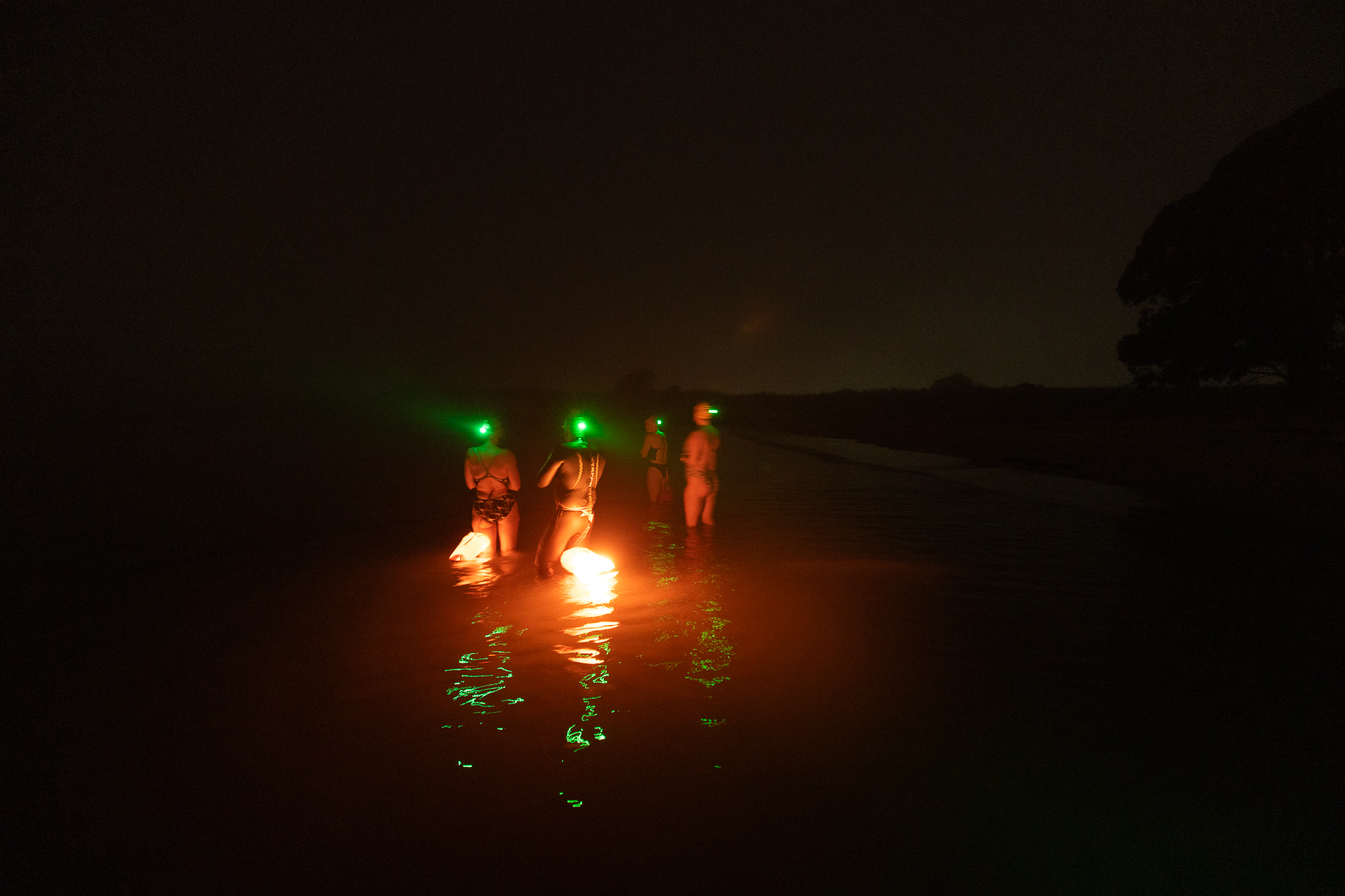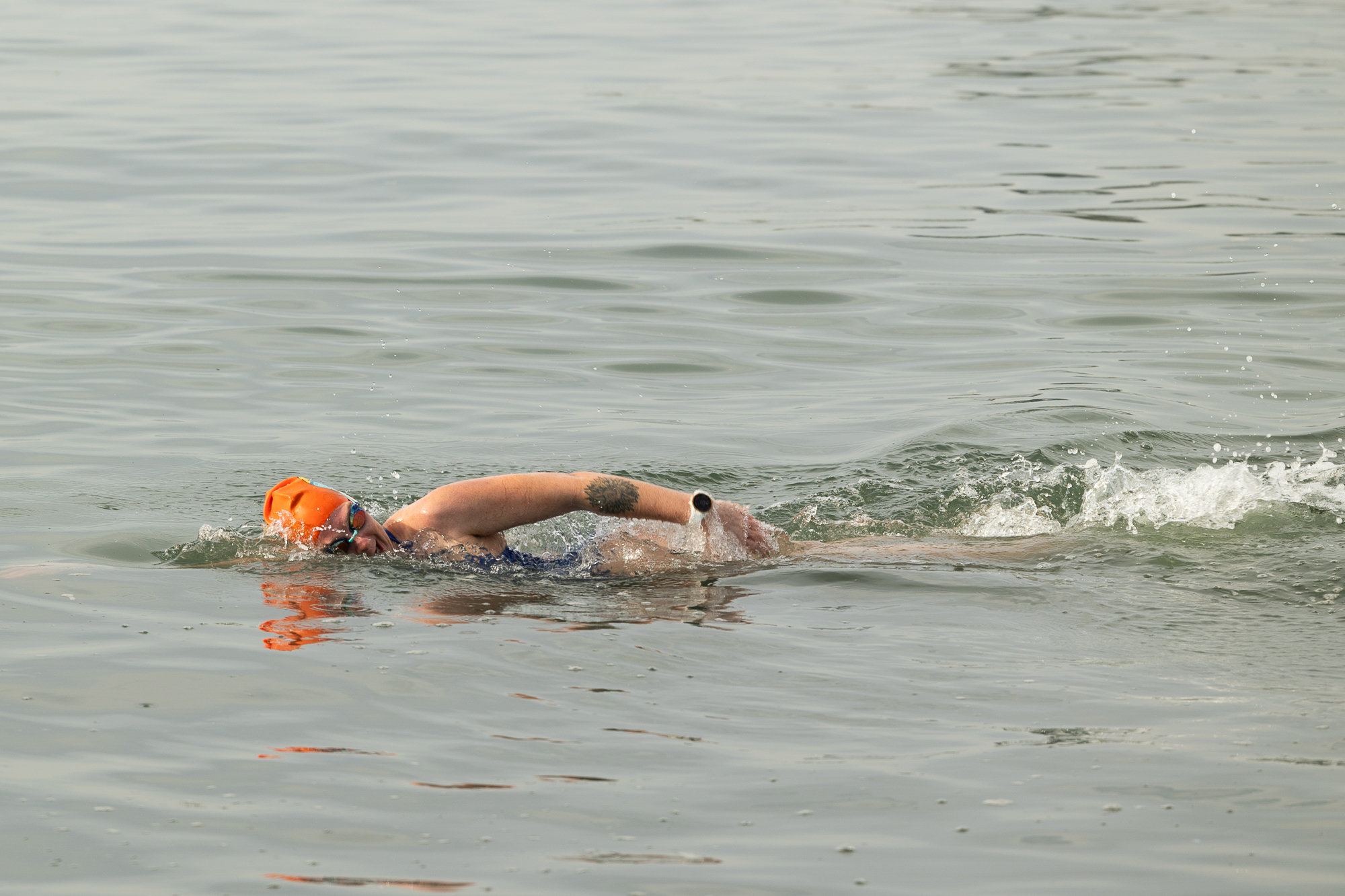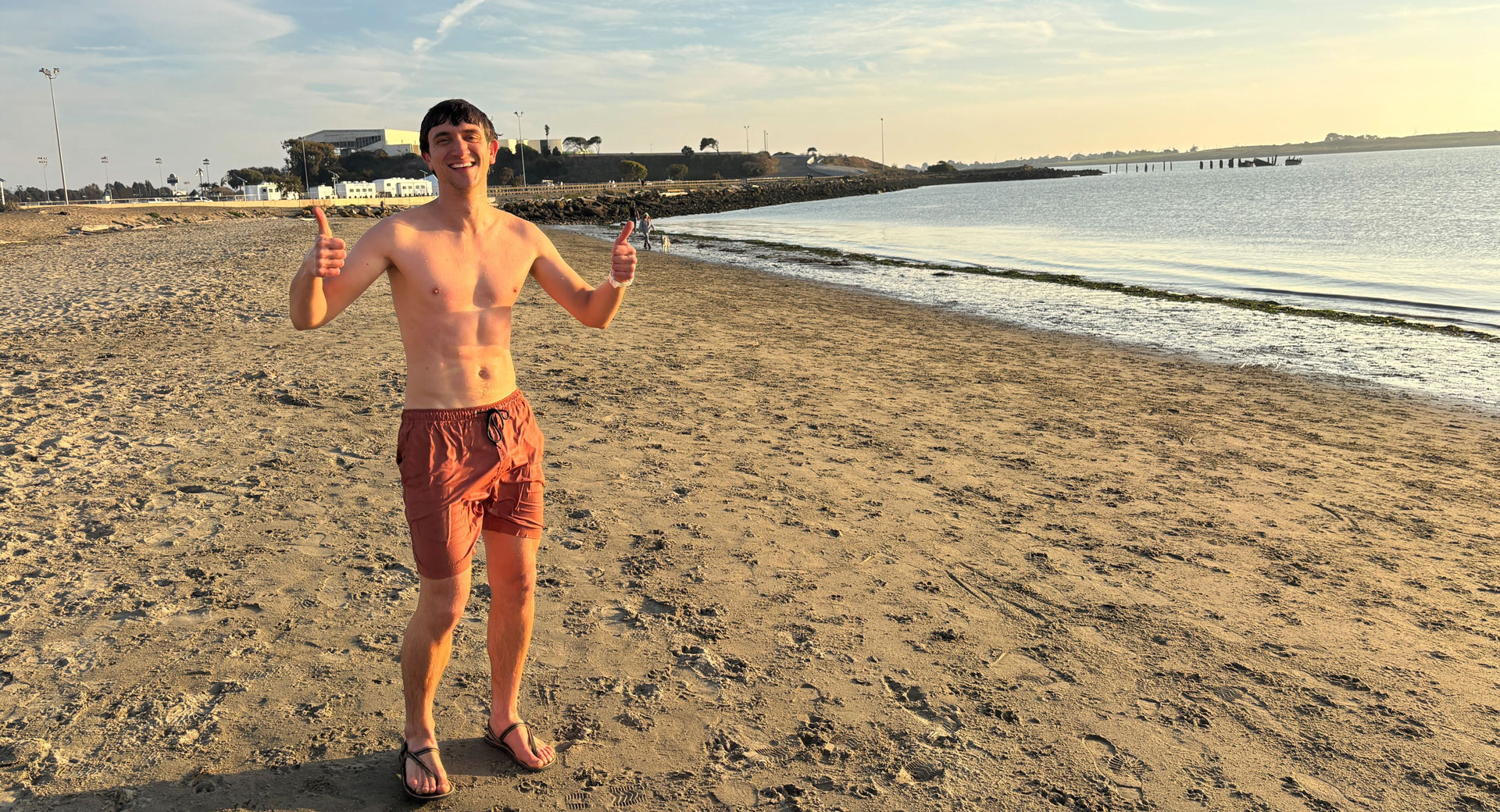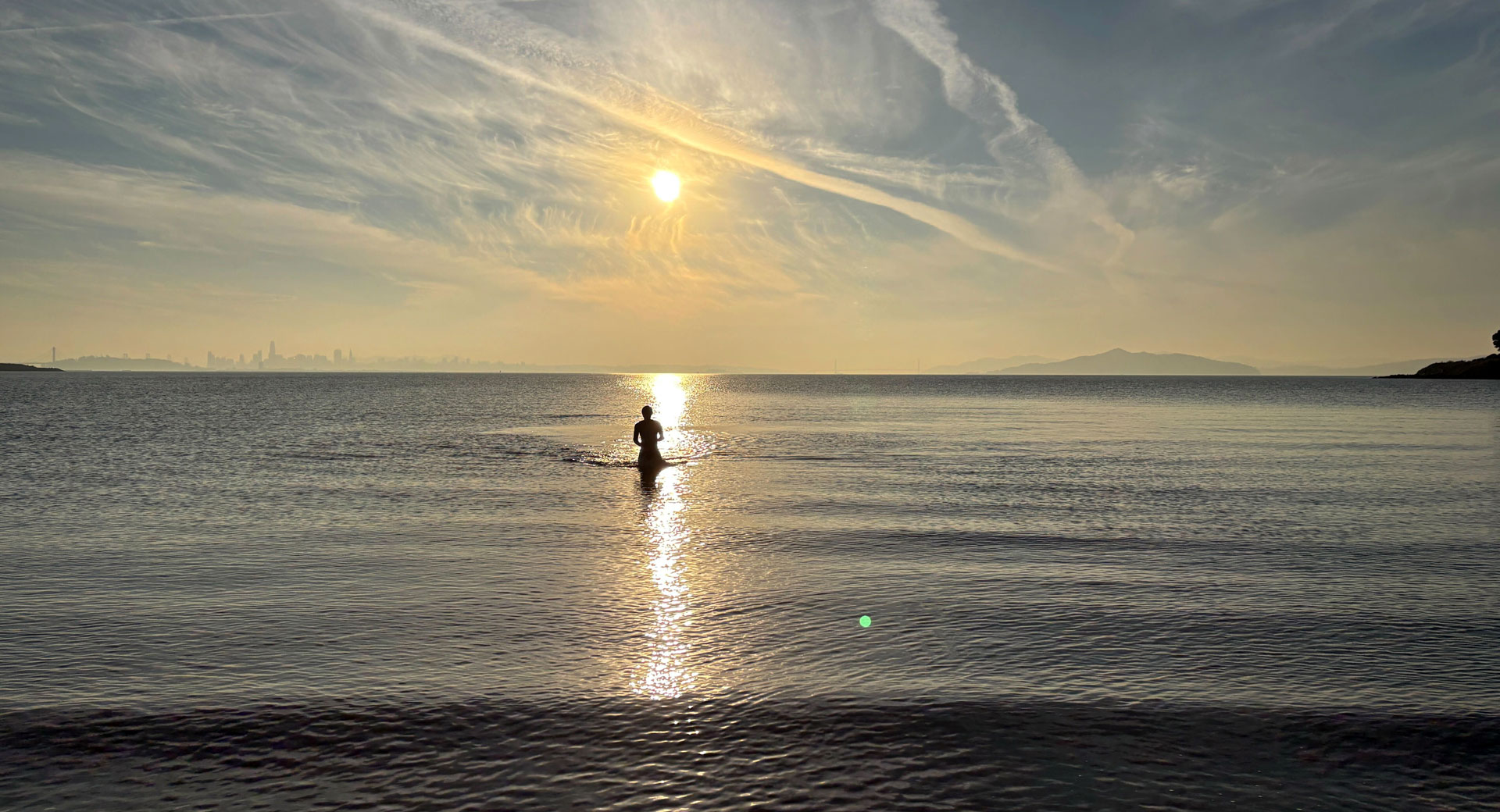Episode Transcript
Olivia Allen-Price: It’s a brisk winter day on Albany Beach in the East Bay. Kerianne Brownlie and I are sitting on a piece of driftwood, overlooking a calm and flat San Francisco Bay. I’m wearing my big winter puffy jacket. Kerianne? She’s in a swimsuit.
Kerianne Brownlie: In 2020, I had made the decision to get back into swimming. I wanted to join a pool team, and with everything closed, I just decided, well, we have a bay right here. That water seems to be open. And so I actually went down to the Berkeley Marina one day on my own and just hopped in.
Stepping into water sounds
Kerianne Brownlie: I remember just getting in and thinking like, okay, this is cold, but it feels okay.
Olivia Allen-Price: She picked a landmark about 500 yards away, put her head down and started swimming toward it. By the time she returned to where she started, she knew she’d discovered something special.
Kerianne Brownlie: And then I felt totally hooked.
Bring up swimming ambi
Kerianne Brownlie: So I work a pretty stressful job as a cardiac ICU nurse. And so really being in the water is the time that my mind is quiet and all of those thoughts shut off and I’m able to just be in the present moment. You feel every little piece of seaweed touching you. You know, you feel the full chilliness of of whatever the temperature is that day. And you get really in tune with your body in a way that I haven’t found in other sports on land.
Olivia Allen-Price: Swimming in the Bay is more than a hobby or a form of exercise. It’s practically a spiritual experience.
Kerianne started out swimming 20, 30 minutes, but was soon drawn to longer swims. Right now, she’s training to swim the English Channel — some 21 miles.
All that brings us to our question asker this week, Robbe Verhofste. He’s taken notice of swimmers in the Bay like Kerianne. He’s been curious about giving it a try himself since he moved here 5 years ago. But, he’s been hesitant.
Robbe Verhofste: For some reason, I’m always drawn to jumping into the waters that face the Pacific. So Stinson Beach or Pacifica or Ocean Beach, and I’m quite a bit more timid to jump in around the interior of the bay itself.
Olivia Allen-Price: Timid because he’s not sure whether it’s safe! No, he’s not afraid of sharks or the cold water.
Robbe grew up in Iowa, where agriculture pollution is a big problem. It can make water dangerous — even lethal — to swim in. So he’s used to thinking twice before jumping into a body of water.
Robbe Verhofste: There it was really clear when the water was safe and the water was not safe.
Olivia Allen-Price: So he’s wondering: what about the bay? Is it safe to swim in?
Robbe Verhofste: If I knew that I was going to come out without issue I would absolutely love to spend more time in this body of water.
Bay Curious theme music begins
Olivia Allen-Price: I’m Olivia Allen-Price, and on today’s episode of Bay Curious: Is it safe to swim in the Bay? Are there certain areas, or times of year, to avoid? Can we convince Robbe to take the plunge? Or will what we find scare him away? That’s all coming up, after this quick break.
Olivia Allen-Price: To find out more about water quality in the bay and to advise Robbe on whether or not to take the plunge we sent out reporter Dana Cronin.
Dana Cronin: Before we get into the current water quality in the bay, I think we need to back up to appreciate how far we’ve come.
Because 60 years ago the answer to Robbe’s question would unequivocally have been “No.”
Eileen White: Back in the 60s, raw sewage from the various treatment plants in the Bay area were going untreated into San Francisco Bay.
Dana Cronin: Eileen White is the executive officer for the San Francisco Bay Regional Water Quality Control Board. That’s the local agency in charge of tracking and regulating what goes into the bay.
And yes, she’s saying that, 60 years ago, when you flushed the toilet, it essentially went straight into the bay. Refineries and industrial facilities also pumped their waste directly into the bay.
But we’ve come a long way since then, in large part because of the passage of the Clean Water Act in 1972.
Eileen White: That required the wastewater treatment plants to do secondary treatment and monitoring, and really cleaned up San Francisco Bay.
Dana Cronin: Now, Eileen estimates that 95 percent of the time, the bay meets national water quality standards. Sixty years ago that number was closer to 20 percent.
So we’ve come a long way!
But, if you’ve been paying attention lately, you know that the bay still has some big problems.
News Clip 1: This is the scene folks up and down the San Francisco Bay have been witnessing for the past two weeks as a harmful algae bloom has taken off.
News Clip 2: Enviro groups say the toxic algae bloom is acting like a deadly wildfire underwater.
News Clip 3: The algae has been found along the shoreline along the shoreline from Emeryville to Albany.
News Clip 4: Algae blooms closing down lakes not in late AUgust or September, but in the beginning of July. That’s unusual.
Dana Cronin: Algae blooms occur when conditions are right: the water’s warm and calm, and the algae has nutrients — like sewage or other runoff — to feed on. Algae is a naturally occurring plant in the bay, and when it blooms, it’s not always a bad thing. But certain algae blooms produce toxins that make them dangerous for animals and humans. Other algae blooms are not toxic, but they eat up all the oxygen in the water, which suffocates fish and other wildlife living there.
That’s what happened two years ago at Lake Merritt in Oakland, when tens of thousands of dead fish and other aquatic critters started washing up on shore. Tests later confirmed, it was an algae bloom, and it killed almost everything living in Lake Merritt.
Environmental scientist Kristina Yoshida remembers it well.
Kristina Yoshida: Honestly, I think it took the fish kills for people to realize how much was in here when they saw all the dead sharks and the bat rays. And there’s the huge striped bass.
Dana Cronin: Lake Merritt is a tidal estuary, meaning it’s not fully enclosed, and is fed by both salt and freshwater. It’s basically an extension of the bay.
I meet Kristina at a boat launch on Lake Merritt. And soon after we get there, we spot what Kristina thinks are tunicates, chunky, worm-like creatures suctioned onto the concrete launch pad.
Kristina Yoshida: It’s sure exciting to see how much the wildlife has come back after the fish kill in 2022, when most of everything died in here.
Dana Cronin: Recently, Kristina and her team started collecting nutrient samples at various locations around the lake to help put together a nutrient management plan, to try to avoid — or at least minimize the impacts — of future algae blooms.
Sounds of a speed boat
Dana Cronin: We launch a small speed boat and start slowly cruising around the lake, going from site to site to collect samples and take down some measurements.
Kristina Yoshida: Here’s your bottles. And I’m going to grab coordinates so we know where we are.
Dana Cronin: She pulls a device hooked to a buoy out of the water, which tracks things like temperature, dissolved oxygen and pH.
Kristina Yoshida: Temperature right now is 21.6.
Dana Cronin: That’s celsius. And it’s cooler than Kristina was expecting. Because we went out in October, just days after an intense heat wave, which warms up the water and can ripen it for an algae bloom.
Kristina Yoshida: I was worried with the heat wave that we were going to get another red tide or algae bloom. Yesterday I got three calls for harmful algal blooms in our region.
Dana Cronin: Luckily, this year, Lake Merritt — and most of the bay — was spared. But algae blooms pop up every year, all over the Bay Area, and they’re getting worse.
It’s another consequence of, you guessed it, climate change.
Kristina Yoshida: We have longer, warmer summers, less precipitation. And so those situations set up perfect conditions for these algae blooms to occur.
Dana Cronin: Kristina says Lake Merritt is primed for another big algae bloom.
And that’s why the sampling is so important because it’s going to help the city take on a plan to make it more resilient to these blooms. The plan is still in its infancy, but the idea is to try to come up with ways to save as many creatures as possible when the next inevitable algae bloom hits.
Quick little disclaimer here, the city of Oakland does not recommend swimming in Lake Merritt. Its relatively small surface area and urban surroundings make it more polluted than other parts of the bay and accidentally ingesting the lake water could be dangerous.
Music starts
Dana Cronin: Let’s get back now to Robbe’s question: Is it safe to swim in the bay? I asked Eileen White, with the water quality control board.
Eileen White: I would say yes, the bay is definitely swimmable…
Dana Cronin: You may sense the caveats coming.
Eileen says she would not recommend swimming in the bay after the first big rainstorm of the year.
Eileen White: The first storm of the year usually brings a lot of pollutants into the bay because it’s washing down all that stuff that’s been there, accumulating all summer and all fall.
Dana Cronin: Things like:
Eileen White: It can be litter. It can be bird poop. It can be dog poop.
Dana Cronin: After any big rain storm, really, Eileen says swimming is riskier.
And in the Bay Area, those big rain storms are becoming more common and more intense with climate change. So-called atmospheric rivers, which park themselves in the sky and can dump feet of rain within a few days, cause even more stormwater to runoff into the bay.
And, Eileen says, that can complicate things for our wastewater treatment agencies. Especially in San Francisco, which has a combined stormwater and wastewater system. That means they have one set of pipes underground through which all water flows out of your toilet, and your storm drain.
That system can get easily overwhelmed, Eileen says.
Eileen White: When they get these really big storms, they can’t store enough, you know, that the runoff is coming. And so not all the stormwater can get treated and the wastewater, full treatment at their plants. And so that can result in some bacteria in the bay in certain parts of the bay.
Dana Cronin: That happens about 10 times per year on average. In total, San Francisco discharges nearly 2 billion gallons of combined stormwater and raw sewage each year.
And that poses a big public health risk for those who recreate in the bay… especially swimmers.
The Environmental Protection Agency along with local environmental groups are currently suing San Francisco for what they say are repeated violations of the Clean Water Act.
San Francisco, in turn, is suing the EPA, saying the agency’s restrictions on how much sewage it can discharge are too vague.
That lawsuit made it all the way to the Supreme Court last year. The justices heard arguments in October, and are expected to present a decision by the time the current term ends in June 2025.
Music starts
Dana Cronin: In the meantime, Eileen says wastewater agencies are required to conduct tests after they accidentally leak sewage and also put up signs in affected areas, which can be anywhere around the bay, including right offshore.
But that doesn’t always deter everyone.
Eileen White: Some swimmers will still decide, you know, they’re the diehard swimmers in the bay. And they may risk getting some skin rash or an infection if they swim in the bay.
Dana Cronin: It might not kill you, but swimming in contaminated water could lead to a fever, vomiting and diarrhea.
My advice? Check local news, city and wastewater agency websites… and look for signs on the beach before you dive in.
There’s no real satisfying yes-or-no answer to Robbe’s question. It’s more like yes, sometimes and no sometimes. It’s yes in some places and no in others.
Is that enough to convince Robbe to take the plunge?
Sounds of waves breaking softly
Dana Cronin: Maybe you could just start off kind of telling me, like, where we are right now and. And what we’re here to do.
Robbe Verhofste: Yeah, we’re on Albany Beach, near sunset, and I’m about to probably jump into the water here.
Dana Cronin: After listening to this episode, Robbe very bravely agreed to meet up with me for his first-ever swim in the bay.
But first, we had to check if the conditions were safe.
Robbe Verhofste: I haven’t seen any signs posted, but I was curious to check out if there are any swim advisories. I just looked up water quality East Bay, and there’s this great website with all of these different parks around the advisories.
Dana Cronin: Robbe pulls out his phone and pulls up the East Bay parks website, which has a map of different sampling points around the East Bay.
Robbe Verhofste: Let’s see, swim beach conditions. It opens as a PDF… All right! Low risk. It’s green.
Dana Cronin: And with that, Robbe takes off his shoes, strips down to his bathing suit and starts walking down toward the water.
He stands on the edge of where the waves are breaking.
Robbe Verhofste: It’s cleaner than I thought at the edge. From a distance it looks a lot more muddy.
Dana Cronin: He wades out, until the water is up to his stomach, almost beyond the reach of my microphone.
He seems ready to plunge, so I give him a countdown.
Dana Cronin: Three, two, one.
Sounds of splashing
Dana Cronin: How’s it feel?
Robbe Verhofste: It’s a bit colder. But I kind of want some more!
Dana Cronin: Yeah!
Dana Cronin: Robbe swims freestyle a few lengths, seems to be enjoying himself. But the cold eventually gets the best of him, and he sloshes back out.
Dana Cronin: Man, How does that feel?
Robbe Verhofste: Exhilarating. Yeah, it’s my whole body’s kind of tingling. It’s definitely a little chilly, but, yeah, I’d recommend others who are curious to give it a shot.
Dana Cronin: Robbe told me he recently signed up for a triathlon. And now that he knows it’s safe to swim in — most of the time — the bay may have just become his new training ground.
Olivia Allen-Price: That was KQED’s Dana Cronin.
After a little hiatus in December, we are back with a new voting round this January. Head online to BayCurious.org to cast your vote — no signing up or annoying hoops to jump through. Here are your options:
Voice Over 1: Who is “Stevens” and why is Stevens Creek in San Jose and Cupertino named after him or her?
Voice Over 2: Why does San Jose have such a high concentration of Vietnamese people?
Voice Over 3: I see peacocks sometimes in the East Foothills of San Jose. They certainly are not native to California. How did they get here?
Olivia Allen-Price: Bay Curious is made by Amanda Font, Christopher Beale and me, Olivia Allen-Price. Katrina Schwartz rejoins us this week after her maternity leave, and we’ve got a new Bay Curious team member — baby Esme.
Sounds of baby babbling
We get additional support from Jen Chien, Katie Sprenger, Maha Sanad, Holly Kernan and the whole KQED Family.
